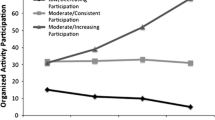Abstract
To explore predictors of adolescent participation in structured out-of-school activities, various types of structured out-of-school time use and their correlates were examined among 454 adolescents in Grades 9–12 in a rural southeastern state. Using a developmental-ecological model as an organizing framework, four different uses of time were explored with regard to self, family, and friend systems. Regression analyses revealed that time in after-school extracurricular activities was predicted by parent endorsement of activities, ethnicity, and friend endorsement of activities, whereas time spent in nonschool clubs was predicted by peer pressure, parent endorsement, and grades. Socioeconomic status, parental monitoring of activities, school grade level, and family structure predicted time spent in volunteering, and time spent in religious-related activities was predicted by ethnicity, family structure, friend endorsement, and gender.
Similar content being viewed by others
REFERENCES
Barber, B. L., Eccles, J. S., and Stone, M. R. (2001). Whatever happened to the jock, the brain, and the princess? Youth adult pathways linked to adolescent activity involvement and social identity. J. Adolesc. Res. 16: 429–455.
Bronfenbrenner, U. (1995). Developmental ecology through space the time: A future perspective. In Moen, P. Elder, G. H., and Luscher, K. (eds.), Examining Lives in Context: Perspectives on the Ecology of Human Development. American Psychological Association, Washington, DC, pp. 619–647.
Brown, B., Clasen, D., and Eicher, S. (1986). Perceptions of peer pressure, peer conformity dispositions, and self-reported behavior among adolescents. Dev. Psychol. 22: 521–530.
Center for Adolescent and School Health (1999). Youth Risk Behavior Survey. Center for Disease Control, Atlanta, GA.
Clasen, D., and Brown, B. (1985). The mulitdimensionality of peer pressure in adolescence. J. Youth Adolesc. 14: 451–467.
Cooper, H., Valentine, J., Nye, B., and Lindsay, J. (1999). Relationship between five after-school activities and academic achievement. J. Educ. Psychol. 91: 369–378.
Demo, D., and Acock, A. (1996). Family structure, family process and adolescent well-being. J. Res. Adolesc. 6: 457–488.
Douthitt, R. A. (1991). Children's time use in single-and two-parent families: Does household organization matter? Home Econ. Res. J. 20: 40–51.
Eamon, M. K. (2002). Effects of poverty on mathematics and reading achievement of young adolescents. J. Early Adolesc. 22: 48–74.
Eccles, J., and Barber, B. (1999). Student council, volunteering, basketball, or marching band: What kind of extracurricular involvement matters? J. Adolesc. Res. 14: 10–43.
Fletcher, A. C., Elder, G. H., and Mekos, D. (2000). Parental influences on adolescent involvement in community activities. J. Res. Adolesc. 10: 29–48.
Floyd, M., Shinew, K., McGuire, F., and Noe, F. (1994). Race, class and leisure activity preferences: Marginality and ethnicity revisited. J. Leis. Res. 26: 158–174.
Gibbons, J. L., Lynn, M., and Stiles, D. A. (1997). Cross-national gender differences in adolescents' preferences for free-time activities. Cross-Cult. Res. 31: 55–69.
Gilman, R. (2001). The relationship between life satisfaction, social interest, and frequency of extracurricular activities among adolescent students. J. Youth Adolesc. 30: 749–767.
Gordon, W. R., and Caltabiano, M. (1996). Urban-rural differences in adolescent self-esteem, leisure boredom, and sensation seeking as predictors of leisure-time usage and satisfaction. Adolescence 31: 883–901.
Huebner, A. (2002). Bridging the gap between research and practice in youth development. Natl. Counc. Fam. Relat. Fam. Focus Brief 15: 23–24.
Huebner, A. (2000-2003). Virginia Adolescent Resiliency Assessment Project. Virginia Agricultural Experiment Station, Blacksburg, VA.
Jordon, W., and Nettles, S. (1999). How students invest their time out of school: Effects on school-related outcomes. Sch. Psychol. Educ. 3: 217–243.
Kleist, D. (1999). Single-parent families: A difference that makes a difference? Fam. J. Couns. Ther. Couples Fam. 7: 373–378.
Larson, R. (2000). Toward a psychology of positive youth development. Am. Psycholo. 55(1): 170–183.
Larson, R., and Verma, S. (1999). How children and adolescents spend time across the world: Work, play, and developmental opportunities. Psychol. Bull. 125: 701–736.
Lerner, R. M. (1995). America's Youth in Crises: Challenges and Options for Programs and Policies. Sage, Thousand Oaks, CA, pp. 14–31.
Mahoney, J., and Stattin, H. (2000). Leisure activities and adolescent antisocial behavior: The role of structure and social context. J. Adolesc. 23: 13–127.
Orthner, D. K., Barnett-Morris, L., and Mancini, J. A. (1994). Leisure and family over the life cycle. In L'Abate, L. (ed.), Handbook of Developmental Family Psychology and Psychopathology. Wiley, New York, pp. 176–201.
Otto, L., and Alwin, D. (1977). Athletics, aspirations, and attainments. Sociol. Educ. 50: 102–113.
Passmore, A., and French, D. (2001). Development and administration of a measure to assess adolescents' participation in leisure activities. Adolescence 36: 67–75.
Pedhazur, E. J. (1997). Multiple Regression in Behavioral Research (3rd edn.). Harcourt-Brace, New York, pp. 15–43.
Perkins, D. F., and Hartless, G. (2002). An ecological risk-factor examination of suicide ideation and behavior of adolescents. J. Adolesc. Res., 17: 3–26.
Pesavento Raymond, L. C., and Kelly, J. R. (1991). Leisure and life satisfaction of unemployed North American urban minority youth. Soc. Leis. 14: 497–511.
Philipp, S. (1998). Race and gender differences in adolescent peer group approval of leisure activities. J. Leis. Res. 30: 214–232.
Raymore, L., Godbey, G., and Crawford, D. (1994). Self-esteem, gender and socioeconomic status: Their relation to perceptions of constraints on leisure among adolescents. J. Leis. Res. 26: 99–118.
Rosenberg, M. (1965). Society and the Adolescent Self Image. Princeton University Press, Princeton, NJ.
Shanahan, M. K., and Flaherty, B. P. (2001). Dynamic patterns of time use in adolescence. Child Dev. 72: 385–401.
Small, S., and Rodgers, K. (1995). Teen Assessment Project. Department of Child and Family Studies, University of Wisconsin-Madison, Madison, WI. (Unpublished manuscript)
Stamps, S. M., and Stamps, M. B. (1985). Race, class and leisure activities of urban residents. J. Leis. Res. 17: 40–56.
Trusty, J., and Watts, R. E. (1999). Relationship of high school seniors' religious perceptions and behavior to educational, career, and leisure variables. Couns. Values 44: 30–39.
Author information
Authors and Affiliations
Corresponding author
Rights and permissions
About this article
Cite this article
Huebner, A.J., Mancini, J.A. Shaping Structured Out-of-School Time Use Among Youth: The Effects of Self, Family, and Friend Systems. Journal of Youth and Adolescence 32, 453–463 (2003). https://doi.org/10.1023/A:1025990419215
Issue Date:
DOI: https://doi.org/10.1023/A:1025990419215




